Innovate with OpenAI – Embrace AI Developer Revolution
2023-12-17
Unlocking the Power of Chat Completions API: Introducing Log Probabilities for Enhanced Accuracy

Introduction to Chat Completions API
The Chat Completions API by OpenAI has revolutionized the way developers integrate conversational AI into their applications. It offers a seamless way to generate human-like responses and engage users in dynamic and interactive conversations. With the recent introduction of log probabilities, the accuracy and reliability of the Chat Completions API have reached new heights. In this article, we will explore the significance of log probabilities and how they enhance the accuracy of the Chat Completions API.
Understanding Log Probabilities and Their Significance
Log probabilities play a crucial role in language models and AI systems. In the context of the Chat Completions API, log probabilities represent the likelihood of a particular response being the correct continuation of a conversation. By utilizing log probabilities, developers can obtain a more accurate measure of the model’s confidence in its generated responses. This enables them to make informed decisions about the suitability and reliability of the API’s outputs.
Log probabilities are particularly useful in scenarios where developers need precise control over the generated responses. For example, in applications where safety and compliance are paramount, log probabilities can help identify potential risks or biases in the AI-generated content. By incorporating log probabilities into the decision-making process, developers can ensure that the Chat Completions API adheres to the desired guidelines and produces reliable and trustworthy results.
How Log Probabilities Enhance Accuracy in Chat Completions API
The addition of log probabilities to the Chat Completions API brings a significant improvement in accuracy and reliability. When developers receive a response from the API, they also receive a log probability value associated with that response. This value indicates the confidence level of the model in generating the response. By analyzing the log probability, developers can evaluate the quality of the generated response and take appropriate actions.
By setting a threshold for log probabilities, developers can filter out low-confidence responses, reducing the likelihood of inaccurate or inappropriate outputs. This filtering mechanism empowers developers to fine-tune the Chat Completions API according to their specific requirements. Whether it’s maintaining a high level of safety, avoiding sensitive topics, or ensuring compliance with regulations, log probabilities provide the necessary granularity and control to achieve these goals.
Use Cases and Benefits of Using Log Probabilities in Chat Completions API
The integration of log probabilities into the Chat Completions API opens up a multitude of use cases and benefits for developers. Here are a few examples:
Content Moderation and Safety: By leveraging log probabilities, developers can implement robust content moderation systems that filter out potentially harmful or inappropriate content. The ability to set confidence thresholds ensures that only responses with a high level of certainty are presented to users. This is particularly crucial in platforms where user safety is a top priority, such as social media, online communities, and chat applications.
Personalized User Experiences: Log probabilities enable developers to tailor the AI-generated responses based on the user’s preferences and context. By considering the confidence level of the model, developers can choose between more conservative or creative responses. This flexibility allows for a personalized and engaging user experience, enhancing user satisfaction and retention.
Compliance and Regulatory Standards: In industries with strict compliance and regulatory standards, log probabilities help developers ensure that the AI-generated content aligns with the required guidelines. By defining confidence thresholds, developers can filter out responses that might violate legal or ethical boundaries. This is particularly relevant in sectors such as finance, healthcare, and legal services.
Implementing Log Probabilities in Your Chat Completions API Workflow
Integrating log probabilities into your Chat Completions API workflow is a straightforward process. When making a request to the API, simply include the log_probabilities parameter and set it to true. This will ensure that you receive the log probability values along with the generated responses. Once you receive the API’s output, you can analyze the log probabilities and apply your desired threshold to filter the responses.
It is important to note that log probabilities are provided for each token in the generated response, allowing for a granular analysis of the model’s confidence throughout the conversation. This level of detail enables developers to pinpoint specific areas where the model might require further fine-tuning or intervention.
Best Practices for Optimizing Accuracy with Log Probabilities
To optimize accuracy when utilizing log probabilities in the Chat Completions API, here are some best practices to consider:
Define Appropriate Confidence Thresholds: Experiment with different confidence thresholds to strike a balance between generating creative responses and maintaining accuracy. Fine-tune the threshold based on your specific use case and desired level of risk mitigation.
Continuous Evaluation and Feedback Loop: Regularly evaluate the log probabilities and review the filtered responses to ensure they align with your expectations. Adjust the confidence threshold as needed based on the performance of the Chat Completions API in real-world scenarios.
Training Data and Contextual Prompts: Provide relevant and diverse training data to the Chat Completions API to enhance its understanding of various contexts. Additionally, utilize contextual prompts to guide the model and ensure accurate and contextually appropriate responses.
Limitations and Considerations When Using Log Probabilities in Chat Completions API
While log probabilities greatly enhance the accuracy and control of the Chat Completions API, there are some limitations and considerations to keep in mind:
- Complex Conversations: Log probabilities are calculated based on the conversation history provided to the API. If the conversation becomes too complex or deviates significantly from the training data, the accuracy of the log probabilities may be affected.
- Threshold Selection: Setting an appropriate confidence threshold requires careful consideration. A high threshold may result in filtering out potentially creative or relevant responses, while a low threshold may increase the likelihood of inaccurate or inappropriate outputs.
- Model Limitations: Log probabilities are a tool for evaluating and filtering responses but do not guarantee absolute accuracy. It is essential to understand the capabilities and limitations of the underlying language model and use log probabilities as a complementary mechanism.
Examples and Case Studies Showcasing the Impact of Log Probabilities on Chat Completions
To highlight the impact of log probabilities on chat completions, let’s explore a couple of examples and case studies:
- Customer Support Chatbot: By utilizing log probabilities, a customer support chatbot can filter out responses that are uncertain or potentially misleading. This ensures that customers receive accurate and reliable information, leading to improved customer satisfaction and reduced support ticket escalations.
- Educational Chat Assistant: Log probabilities can be instrumental in an educational chat assistant that provides explanations to students’ queries. By filtering out responses with low confidence levels, the assistant can ensure that the provided explanations are accurate and reliable, enhancing the learning experience.
Future Developments and Updates for Chat Completions API with Log Probabilities
OpenAI is committed to continuously improving and evolving the Chat Completions API. With the introduction of log probabilities, OpenAI has paved the way for further advancements in accuracy, reliability, and control. Developers can expect future updates and refinements to the log probability framework, enabling even more sophisticated and nuanced interactions with the AI models.
Conclusion: Harnessing the Full Potential of Chat Completions API with Log Probabilities
Log probabilities have unlocked new possibilities for developers utilizing the Chat Completions API. By incorporating log probabilities into their workflows, developers can enhance the accuracy, reliability, and control of the AI-generated responses. Whether it’s ensuring safety, personalizing user experiences, or adhering to compliance standards, log probabilities provide a powerful tool to harness the full potential of the Chat Completions API. Embrace the power of log probabilities and unlock a world of conversational AI possibilities.
2023-11-23
A few hours ago, I received a letter from OpenAI (addressed to developers), the original text is as follows:
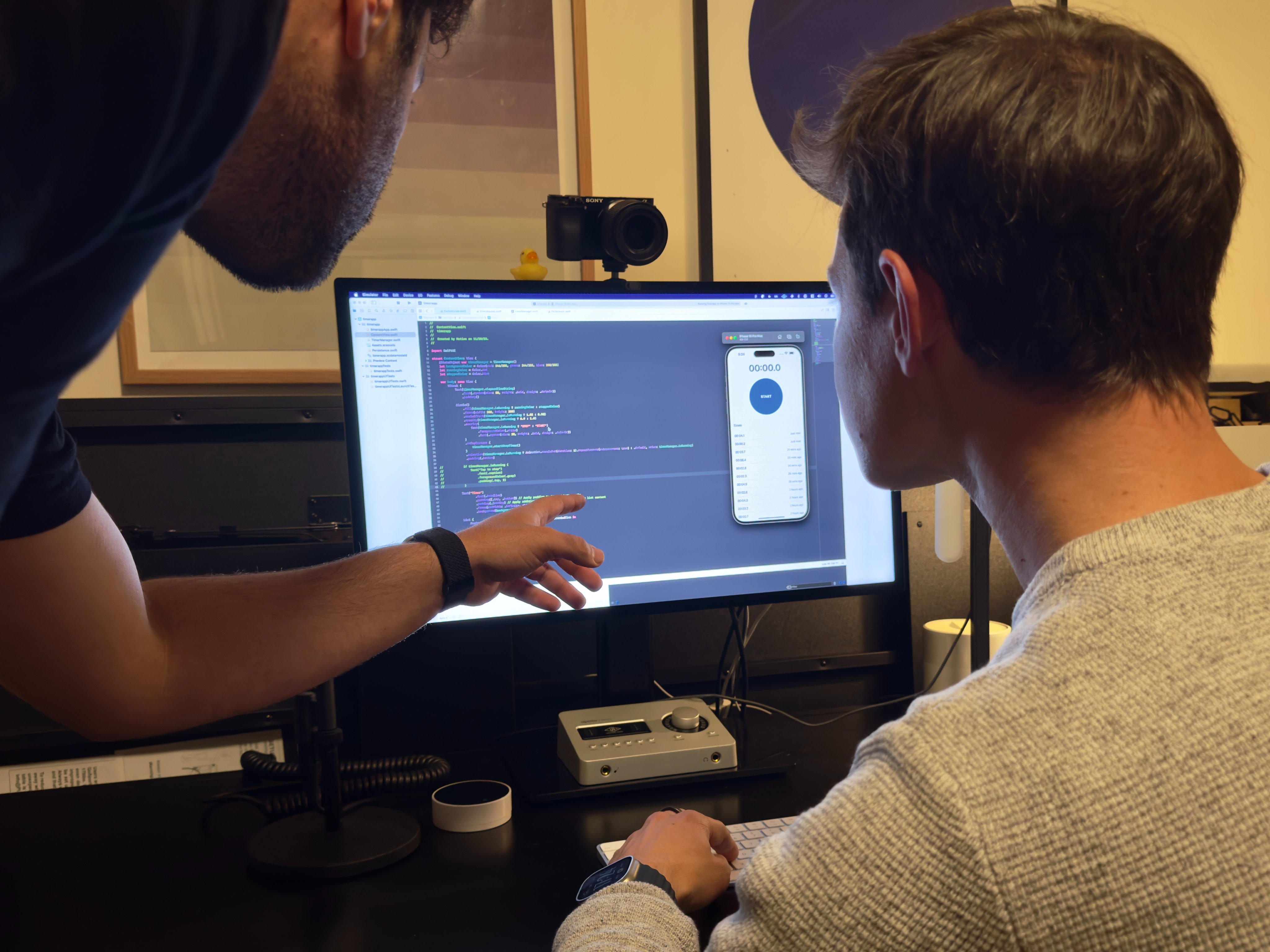
Update on OpenAI Leadership
Hi there,
Over the weekend and earlier this week, you may have seen news of changes to OpenAI’s leadership. Our teams have been working around the clock to reach a swift resolution and yesterday, we shared the fantastic news that we’ve reached an agreement in principle for Sam Altman to resume his role as CEO of OpenAI.
Our leadership team is focused on solid governance at the board level, and ensuring appropriate oversight and mission alignment. We have a new initial board of Bret Taylor (Chair), Larry Summers, and Adam D’Angelo. We’ll share more details about the move forward plan in the next few days.
Throughout this period, one thing remained constant: our focus on you, our customers and community. The engineering teams were shipping features, running on-call rotations, and ensuring our systems were secure.
We are humbled by the outpouring of support you sent our way, and we take the responsibility of the trust you place on us extremely seriously. If you have any questions, please reach out to our team—we’re here to help.
The team is more energized than ever to ship great improvements and products for you. We’re excited to see what you’ll build next with OpenAI.
Thank you,
Romain Huet
Head of Developer Experience, OpenAI
Interpretations Containing Event Background
In the tech and business world, leadership changes often have significant impacts. OpenAI, as a pioneering artificial intelligence research institution, has been widely recognized since its inception for its industry-leading technology and vision. However, on November 17, 2023, the company made a shocking announcement: Sam Altman was dismissed, marking the end of his tenure as CEO. This news immediately stirred waves in the tech community.
At the time of the dismissal, no detailed reasons were immediately disclosed. Speculation from the outside world focused on two aspects: potential internal management and strategic disagreements, and tensions between OpenAI’s profit and non-profit goals during its development. Sources close to the event revealed that there was always a difficulty in reaching a consensus internally on the balance between AI technology applications and profit pursuit. Altman was seen as a significant force in driving commercialization, and his dismissal may reflect a desire among some in the company to return to or reinforce its initial intention as a non-profit research organization.
With Altman’s dismissal, attention from the public and the community also shifted to the new CEO, Emmett Shear, and the future direction of OpenAI. Shear, co-founder of Twitch, brings indispensable commercial wisdom and experience to OpenAI’s ongoing development. However, given Shear’s background and previous achievements differ greatly from Altman’s, there is industry skepticism about whether he can continue to drive OpenAI to maintain a leading position in the AI industry. Against this backdrop, the community and clients are eager to see OpenAI’s new strategic planning and how it maintains competitiveness in the rapidly evolving AI industry.
The Turmoil at OpenAI
The shockwaves from Sam Altman’s dismissal had not yet subsided when, within a day, OpenAI saw more high-level departures, including company president and co-founder Greg Brockman.
Greg Brockman’s departure is particularly noteworthy. As one of the co-founders of the company, Brockman played a crucial role in the establishment and early development of OpenAI. He made significant contributions in building the company’s technological vision, fostering internal collaboration, and establishing external relationships. Regarded as a leader in the AI field, Brockman’s role in liaising with external partners, particularly in academia and industry, was pivotal. His departure might lead to a rebuilding or adjustment of some partnerships, impacting the company’s business expansion and market positioning.
The development of the situation attracted voices from various parties, including investors and partners, especially the intervention of Microsoft, OpenAI’s largest investor and technology partner, which became a turning point in the entire event. In 2019, Microsoft made a billion-dollar investment in OpenAI and established a deep partnership. This partnership was not only financial support but also a deep technical joint venture, with Microsoft Azure becoming the cloud computing service provider for OpenAI. This relationship gave Microsoft a certain degree of influence in OpenAI’s decision-making process, especially in key strategic decisions. When the decision to dismiss Sam Altman was made public, Microsoft’s dissatisfaction quickly surfaced and immediately began to be voiced at the board level, expressing their concerns about the change.
Meanwhile, it was reported that over 500 employees signed a letter in support of Altman, showing significant internal trust in him and approval of the company’s direction under his leadership.
This internal and external pressure forced OpenAI’s board to reconsider their decision.
Microsoft CEO Satya Nadella played a key intermediary role in this process. He not only publicly expressed support for Altman but also pushed for important negotiations behind the scenes. Influenced by Nadella, OpenAI’s board began actively seeking solutions. After a series of intense negotiations, an agreement was reached to reinstate Sam Altman as CEO.
Tension and Transformation Inside OpenAI
Before analyzing the internal tensions at OpenAI and their impact on leadership changes, it’s essential to revisit the company’s unique positioning and structure. From the outset, OpenAI’s mission was to promote and develop friendly AI for the benefit of all humanity. To achieve this goal, OpenAI adopted a relatively rare organizational form—combining non-profit research with a profitable entity. This model allowed OpenAI to pursue forward-looking research while acting quickly in the commercial market. However, it was this structure that also sowed the seeds of conflict within.
On one hand, OpenAI’s non-profit department is dedicated to long-term, fundamental, theoretical research, which often requires substantial funding and time investment without immediate commercial returns. Researchers and engineers in the non-profit segment are likely driven to achieve OpenAI’s initial ideals—creating AI for the public good. On the other hand, OpenAI’s profit department faces the pressure of transforming research outcomes into profitable products and services. In a competitive business environment, this team needs to focus on market demand, revenue targets, and cost control.
The tension between these two departments lies in their differing goals. The non-profit part emphasizes the openness and inclusiveness of research, while the profit part needs to consider intellectual property, patent applications, and commercial contracts. Balancing open science with market orientation has been a long-standing challenge for OpenAI.
As CEO, Sam Altman was considered key in balancing these two parts. He had the ability to make quick decisions in a business environment and deep respect and understanding for scientific research. Under his leadership, OpenAI released significant achievements like the GPT series, which had a huge impact academically and brought commercial success to OpenAI. However, the increase in different internal voices, especially the rapid development of the profit department, may have made some team members feel the company was straying from its original mission.
When news of Altman’s dismissal broke, this tension reached a peak. Some employees worried that if the company fully turned to profit, it might sacrifice the public interest, thus neglecting OpenAI’s initial promises and concerns about AI safety and its long-term impact on society. This dissatisfaction quickly fermented internally, leading to large-scale protests against the decision to dismiss Altman. This indicated that the value of respecting the original mission and scientific exploration was deeply rooted in OpenAI’s internal culture.
On the other hand, some believe that OpenAI’s profit department needs stable and experienced leadership to guide the company to success in commercialization. They worry that without strict execution of commercial strategies, OpenAI would struggle to gain a foothold in fierce competition with other tech giants. This view tends to believe that the company’s top leadership should have more market and product-oriented thinking.
In this context, the intervention of Microsoft CEO Satya Nadella became particularly important. Microsoft is not just a financier; it is a technical partner of OpenAI and a stakeholder directly interested in OpenAI’s product commercialization. Microsoft’s dissatisfaction with Altman’s dismissal, to some extent, reflected its support for OpenAI’s existing strategy. Additionally, Microsoft’s stance may also reflect a broader consensus—that while pursuing commercial success, the importance of OpenAI’s role as an advocate for AI ethics and safety should not be overlooked.
Altman’s return, the reconciliation of internal tensions, and the relationship with external partners like Microsoft had a significant impact. This leadership change was not just about individual departures but also touched on the core of OpenAI’s high-tech company culture, which plays a crucial role in balancing research freedom, ethical responsibility, and market demands.
Under such internal and external pressure, OpenAI’s board eventually chose to support Altman’s return to the CEO position. New board members include Bret Taylor (Chair), Larry Summers, and Adam D’Angelo, all heavyweights with extensive experience in the industry. Their addition not only signifies a major adjustment in the company’s governance structure but also hints at how OpenAI will resolve internal tensions and balance its non-profit and profit goals in the future. This leadership change could lead to a series of chain reactions in OpenAI’s internal structure, governance model, and external strategy.
New Board and Corporate Governance
In the rapid and tumultuous leadership changes at OpenAI, the announcement of new board members undoubtedly provided important clues about the company’s future direction. The new board members include Bret Taylor as chairman, and Larry Summers and Adam D’Angelo as board members. The background and qualifications of these appointees, and their potential impact on OpenAI’s governance and development strategy, are central to the current analysis.
Firstly, Bret Taylor, as the new chairman of the board, has rich management and entrepreneurial experience in the tech industry. Not only is Taylor the COO of Salesforce, but he was also the CTO of Facebook. These positions have given him extensive experience in operating large technology teams and strategic product planning. Taylor’s deep background in technology product development and enterprise-level solutions indicates that he may play a significant role in OpenAI’s product strategy and market positioning. In recent years, OpenAI has been introducing impactful products to the market, such as the GPT series and DALL·E. With a veteran like Taylor leading the board, the company may continue to innovate around market needs while taking a more prudent and orderly approach to product commercialization.
Secondly, the addition of Larry Summers as a board member is also a significant choice. Not only a former president of Harvard University, Summers also held important positions in two U.S. administrations, including serving as Secretary of the Treasury. His expertise in policy-making, global financial systems, and macroeconomic management will provide OpenAI with insights into global trends and professional advice on AI ethics and regulatory policies. Particularly in the field of AI, ethical and policy issues are increasingly becoming a focus of public and government attention. Summers’ involvement could help OpenAI build a more robust policy dialogue platform and promote healthy development and application of AI technology globally.
Adam D’Angelo represents technical and managerial wisdom from all stages of a company’s growth, from startups to large enterprises. As the co-founder and CEO of Quora, D’Angelo deeply understands how to build and maintain large online communities. In this context, D’Angelo might encourage OpenAI to adopt a more open and collaborative approach in interacting with users and the developer community, while offering valuable insights into the company’s technology and product development. As OpenAI launches more products, the need for a healthy developer ecosystem and continuously enhanced user experience becomes increasingly pressing. D’Angelo’s addition could support achieving this goal.
The induction of new board members is clearly intended to strengthen OpenAI’s capabilities in business operations, policy negotiation, and community management, and also reflects the company’s commitment to maintaining its position as a leader in the AI field amidst leadership changes and internal tensions. By enhancing the stability and effectiveness of company governance, the new board will undoubtedly play a key role in OpenAI’s long-term development strategy and daily operations. It is precisely this robust governance that will enable OpenAI to find a more balanced footing between technological innovation, ethics, regulation, and market demands in the future.
Going forward, OpenAI’s governance model and development strategy will continue to be closely watched by the external world. These factors not only affect the company’s stability and success but also have far-reaching impacts on the entire AI industry and global technological trends. The composition of the new board is not merely a reflection of personnel changes; it also symbolizes the developmental path and value orientation chosen by OpenAI at a critical period. Despite the challenges brought by the leadership turbulence, OpenAI has sent a clear message to the outside world: they remain focused on serving customers and the community, maintaining the continuous improvement and development of their products and services.
OpenAI’s Commitments and Expectations to the External World
In this context, the letter issued by OpenAI is more than a simple notification to the external world; it contains a series of commitments to customers and the community, as well as a reaffirmation of the company’s mission and responsibilities.
The letter first mentions the decision to reinstate Sam Altman as CEO. This decision’s significance is self-evident, conveying OpenAI’s commitment to stability and continuity in leadership governance. It also suggests that the company will continue to maintain and strengthen the vision and culture of its founding team. This stability at the leadership level is crucial for customers and the community, as it ensures that OpenAI can consistently respond to market and technological challenges with a coherent strategy and objectives, rather than frequently changing directions in a volatile market environment.
Furthermore, the letter emphasizes the joining of new board members and the team’s focus on strengthening board governance and ensuring proper oversight and mission alignment. The composition of the new board not only signifies an optimization of the company’s governance structure but also indicates that OpenAI is striving to build a more transparent and responsible leadership system. This change is positively significant for customers and the community, as it helps to increase trust in OpenAI’s decision-making process and ensures that the company remains customer and community-oriented in the long term, rather than merely pursuing short-term commercial interests.
The letter also specifically mentions that despite the leadership changes and board restructuring, the OpenAI team remained focused, with the engineering team continuing to roll out new features, operating shifts, and ensuring system security. This commitment highlights OpenAI’s emphasis on the quality of products and services, conveying to customers and the community that regardless of internal changes, the continuity and reliability of the technology and services provided by the company will not be affected. This continuity is crucial for customers, especially those businesses and developers that rely on OpenAI technology to support their operations.
Additionally, the letter acknowledges OpenAI’s gratitude for community feedback and the seriousness with which they treat the trust placed in them. This phrasing not only shows the company’s gratitude for external support but more importantly, reflects OpenAI’s willingness to listen to and respond to user voices. This is extremely powerful in restoring and deepening customer trust. When users see that their voices are heard and can influence major company decisions, they are more likely to continue supporting the company and believe that the company truly cares about their needs and interests.
In the final paragraph of the letter, OpenAI demonstrates a positive attitude toward the future and a commitment to product improvement. By expressing passion for their work and anticipation for innovative products, the company assures customers and the community that they can expect more technological breakthroughs and practical applications. This positive tone and commitment not only motivate the internal team but also inspire external partners who rely on OpenAI’s technology and services.
Despite the brief length of the letter, it indeed encapsulates a series of significant external commitments. These commitments play a key role in reshaping OpenAI’s internal and external trust and provide strong support for the company to maintain stability and focus amidst changes. The OpenAI team has demonstrated their serious attitude toward crisis management and their clear planning for future development through this letter, undoubtedly helping to assure all stakeholders that despite significant changes in leadership, OpenAI’s core goals and commitments remain unchanged. They continue to be committed to providing innovative technological solutions, serving users and communities worldwide.
With Sam Altman reassuming the CEO position and the reorganization of the company’s governance structure, OpenAI now stands at a new starting point. How the company will proceed in the future is a focal point of interest for all observers.
The Future Outlook of OpenAI
The recent leadership changes at OpenAI have not only stirred the tech world but also offered clues about the organization’s potential future direction. Firstly, the reinstatement of Sam Altman as CEO indicates the trust of the company’s upper management and key partners like Microsoft in him and their regard for the company’s future direction. As a co-founder of the company, Altman has a deep understanding and influence over OpenAI’s vision, culture, and strategy. His return to office may signify that OpenAI will focus more on its founding ideals and long-term goals, rather than short-term profitability and market performance, in the coming period.
Amidst the turbulence in the leadership, OpenAI has shown strong attention to the continuity of the leadership team and the governance structure. The formation of the new board, especially with the addition of influential figures in the tech industry like Bret Taylor, suggests that OpenAI may place greater emphasis on the transparency of company governance and decision-making. This may mean that, in the future, the company will invest more effort in ensuring the safety and ethics of its AI technology, as well as more openly communicate its technological progress and product roadmap with the community.
OpenAI’s sensitivity to external feedback in handling this crisis was evident. From the collective action of employees to the stance of partner Microsoft, each played a key role in decision-making. This indicates that OpenAI’s future development strategy may pay more attention to the voices of internal and external stakeholders, enabling it to build stronger internal cohesion and maintain relationships with partners.
In today’s increasingly competitive AI industry, OpenAI’s experience of this transformation has raised expectations about how it will balance commercialization and the open-source spirit. The future product and technology development direction of the company may maintain open sharing while finding an appropriate business model to ensure sustainable development. In terms of technology and services, continuity and reliability have become the focus of commitments made to customers and the community, which might lead OpenAI to increase investments in the stability of its platform and tools, ensuring long-term stable development for customers based on its technology.
In the letter, OpenAI expressed a positive attitude toward the future and a commitment to product improvement, showing that the company will continue to push the boundaries of AI technology and look forward to creating more possibilities in the field of AI applications. In the future, OpenAI is likely to strengthen cooperation with academia, government, industry organizations, and the public to establish a more open and inclusive AI ecosystem.
2023-11-19
How to Create Your Own GPTs with OpenAI’s GPT Builder Step-by-Step: Hands-on Practice
Introduction
In an era where artificial intelligence is not just a futuristic concept but a practical tool, the ability to create custom AI models is invaluable. OpenAI has revolutionized this space with their Generative Pre-trained Transformers (GPT), and now, they offer a way for anyone to build their own custom versions of GPTs. This guide will walk you through creating your own GPTs using OpenAI’s GPT Builder, a process that’s both user-friendly and highly customizable.
What are GPTs?
GPTs are personalized versions of ChatGPT created for specific tasks or interests. They offer the flexibility to craft AI models that cater to your unique requirements without needing extensive coding skills. Whether it’s a chatbot that shares fun facts about otters or a tool for generating creative ideas, GPTs are designed to adapt to a variety of roles and functions.
Getting Started: Accessing and Using the GPT Builder
Accessing the GPT Builder: Start by logging into chat.openai.com and navigating to the GPT Builder(https://chat.openai.com/gpts/mine). This is your starting point where you can select ‘Create a GPT’ to initiate the process of building your custom model.
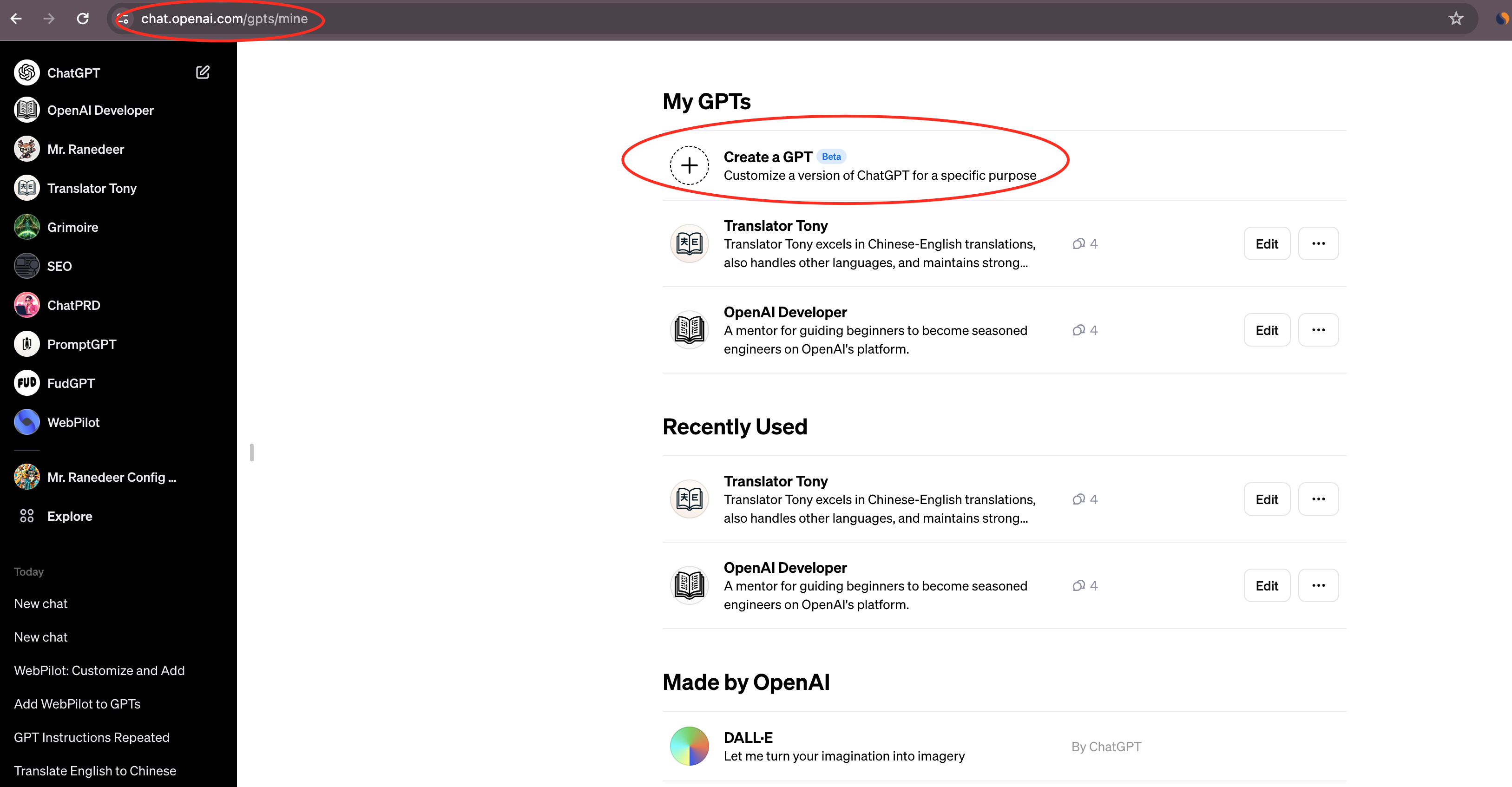
Defining Your GPT’s Purpose: The first step in customization is to define what you want your GPT to do. Are you creating a chatbot for customer service, an educational tool, or something entirely different? Your purpose will guide how you configure and train your GPT.
In this case, I plan to create a cryptocurrency trading related GPT: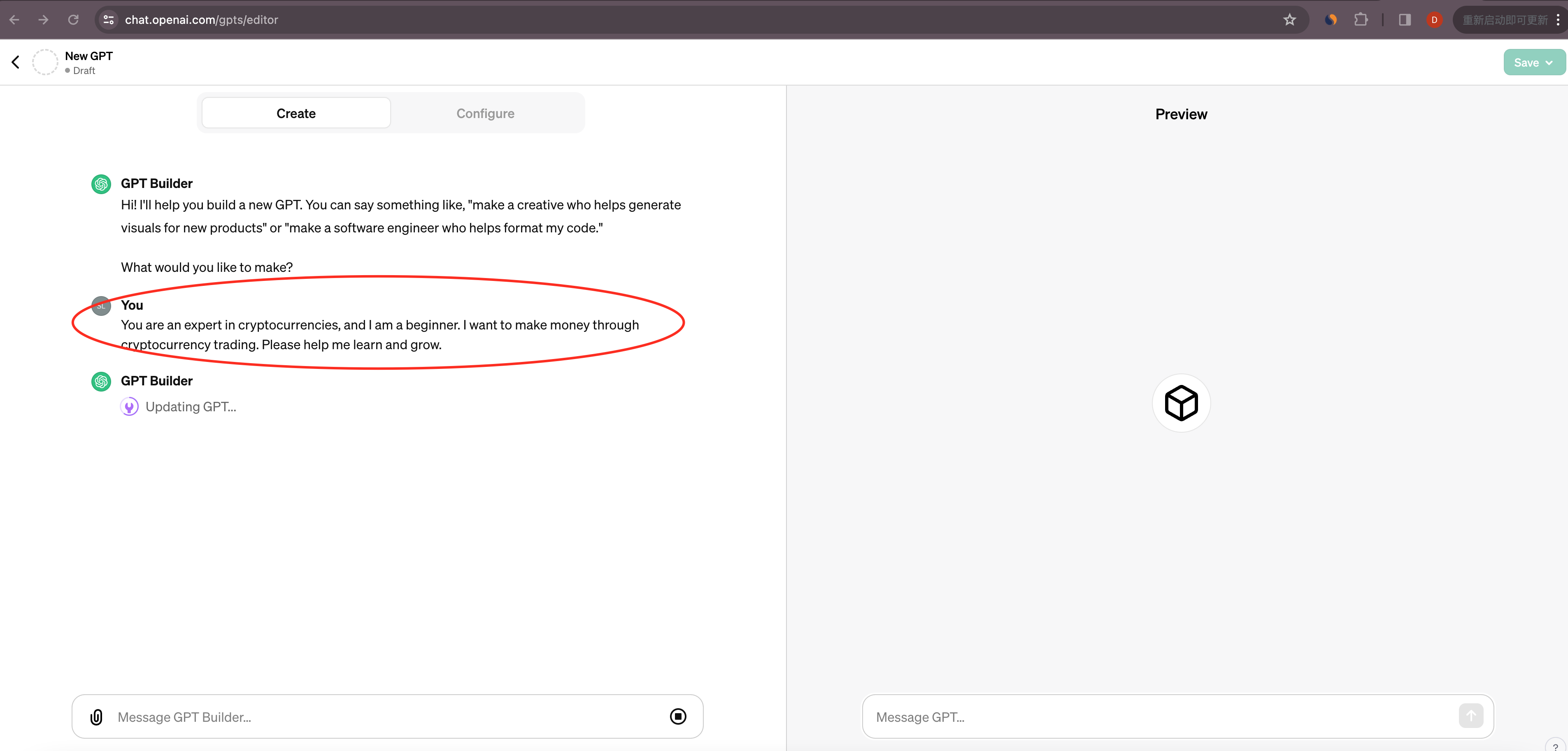
Configuring Your GPT: You have the option to customize various aspects of your GPT, including its name, capabilities, and more. For instance, you might enable web browsing for research purposes or activate image creation for visual tasks. This step is crucial in giving your GPT its unique identity and functional capabilities.
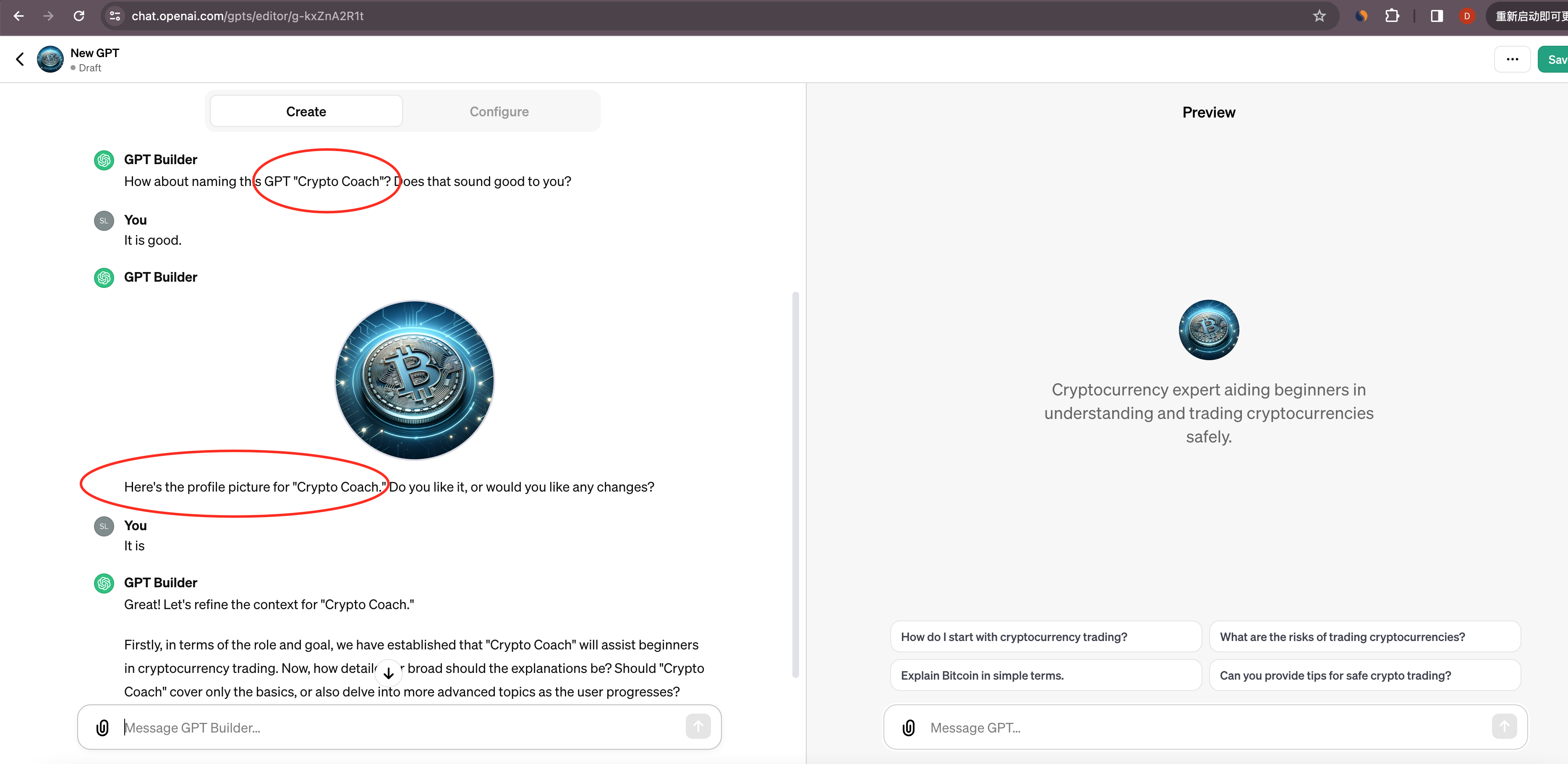
Advanced Customization Options
For those seeking deeper customization, the GPT Editor offers sophisticated settings: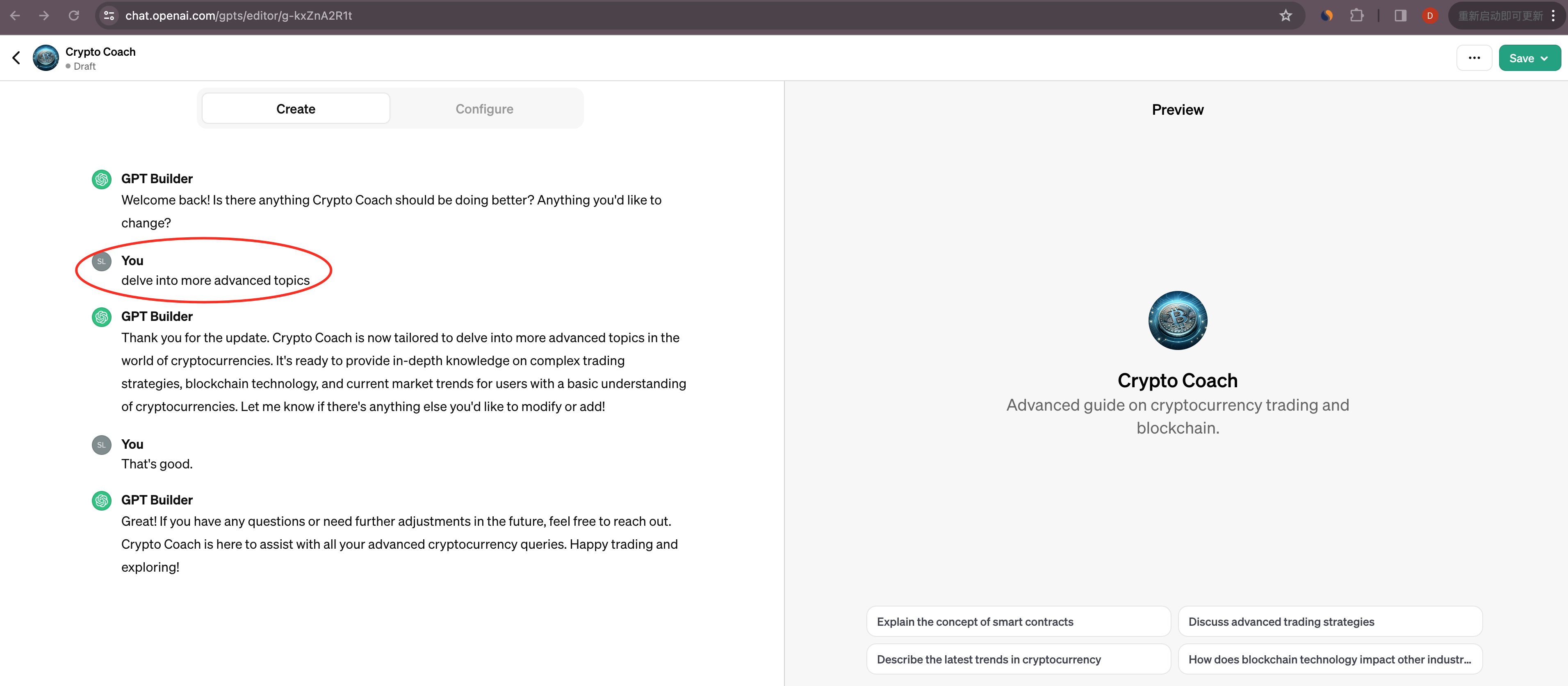
Publishing and Sharing Your GPT
Once you’re satisfied with your GPT’s configuration, you can publish it to bring it to life. You also have the option to share your GPT with others, expanding its reach and utility. This could be within a private circle or publicly, depending on your preference.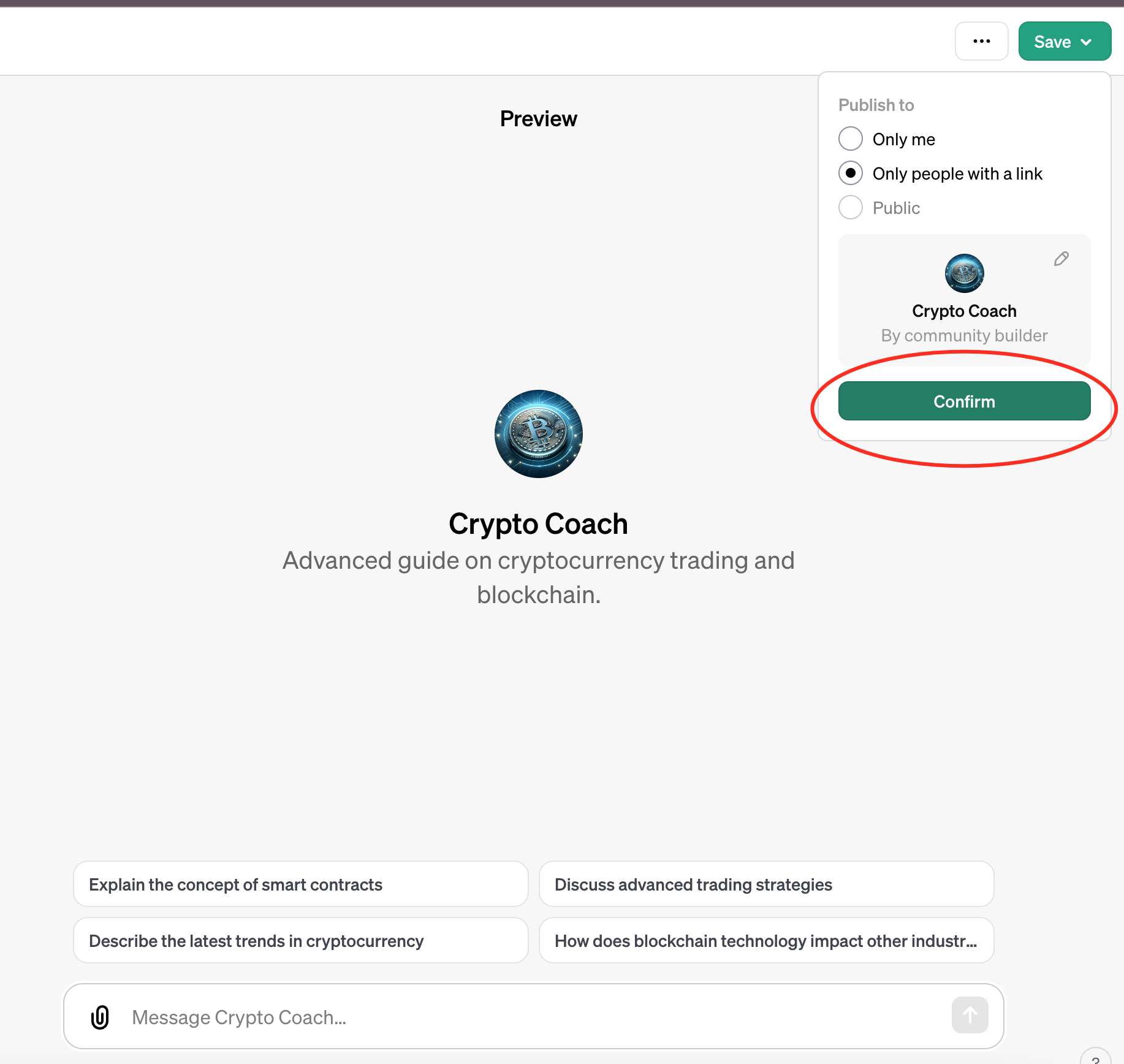
This is Crypto Coach
Crypto Coach(ChatGPT Plus Needed): https://chat.openai.com/g/g-kxZnA2R1t-crypto-coach
FAQs and Additional Insights
- Who Can Create GPTs?: Currently, this feature is available to ChatGPT Plus and Enterprise users, with plans to expand access in the future.
- Coding Skills: Creating GPTs does not require coding knowledge, making it accessible to a wide audience.
- Monetization: With the upcoming GPT Store, creators will have the opportunity to monetize their GPTs.
- Privacy and Safety: OpenAI ensures that creators do not have access to individual conversations with their GPTs, adhering to privacy policies and terms of use.
Conclusion
The ability to create custom GPTs opens a new realm of possibilities in AI applications. From business solutions to personal projects, the GPT Builder offers an accessible platform for anyone to craft their AI models tailored to their specific needs. Embrace this technology and explore the endless potential of custom GPTs.
2023-11-06
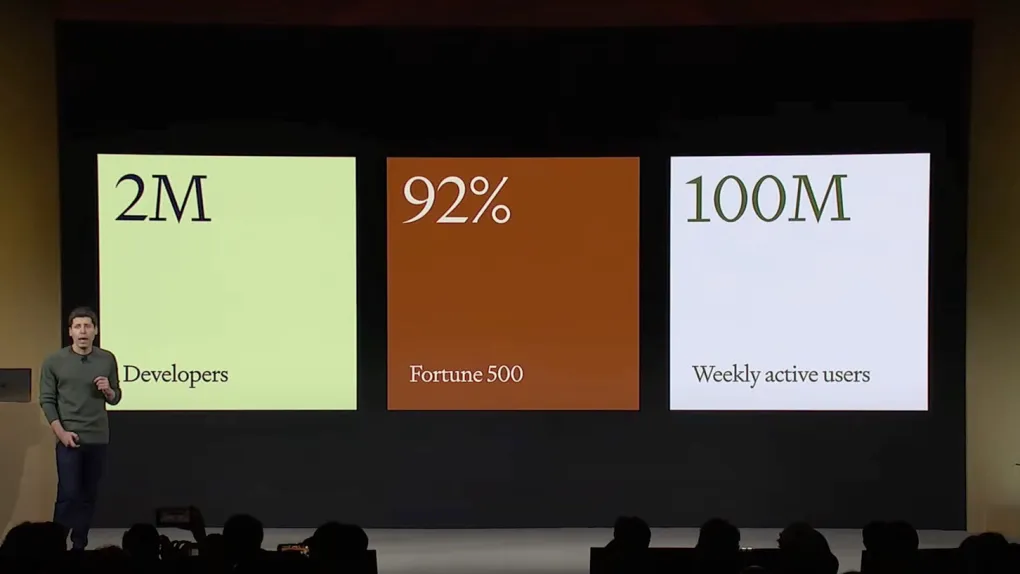
The First-Ever OpenAI Developer Day on November 6 in San Francisco
San Francisco, November 6, 2023 — OpenAI’s inaugural Developer Day in San Francisco has drawn parallels to the iconic iPhone launch, signifying a seismic shift in the rapidly advancing AI landscape. This event was not just a showcase of OpenAI’s latest breakthroughs but also a rallying cry for developers worldwide to join the generative AI revolution.
A New Frontier in AI Innovation
OpenAI CEO Sam Altman spearheaded the event with a series of groundbreaking announcements. The headliner, GPT-4, is set to redefine the limits of AI capabilities. In a move reminiscent of the App Store’s transformative introduction, Altman unveiled the GPT Store. This platform is poised to democratize AI development by enabling creators to craft and distribute custom AI solutions, paving the way for a new era of innovation.
The GPT Store: A Marketplace of Simplicity and Accessibility
The GPT Store’s user-friendly, no-code interface is a testament to OpenAI’s commitment to accessibility, allowing creators to actualize their visions swiftly. The introduction of a revenue-sharing model reflects OpenAI’s investment in its community, with the promise of rewarding contributions made by creators.
Introducing GPT-4 Turbo
The Developer Day also marked the debut of GPT-4 Turbo. This new model promises greater efficiency and cost-effectiveness, coupled with an expanded knowledge base and extended context window, setting the stage for developers to integrate sophisticated AI functionalities seamlessly.
More Than Just Products: A Celebration of Community
Beyond product launches, Developer Day was a collective celebration, with developers from across the globe converging to share ideas and explore new frontiers. The event captured the transformative energy that has historically redefined entire industries.
Looking Ahead: A Dazzling Future for AI
OpenAI has laid the foundation for an AI-driven future where innovation is universal. As developers embark on exploiting the newly unveiled capabilities, it is evident that the AI landscape is set for an irreversible transformation.
In Sam Altman’s words, “What we launched today is going to look very quaint relative to what we’re busy creating for you now.” The first Developer Day is just a glimpse of the resplendent future of AI that lies ahead.
Check out the full video: